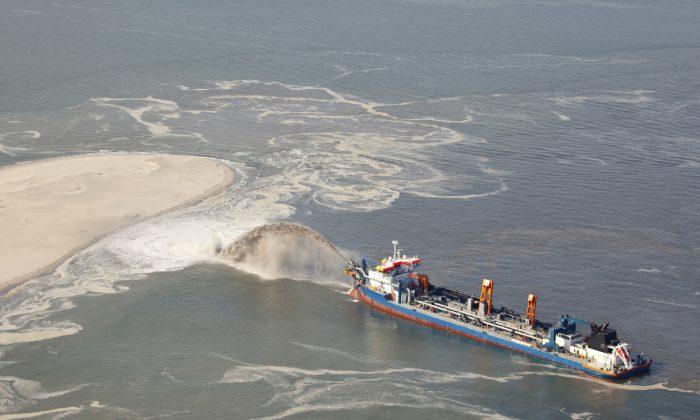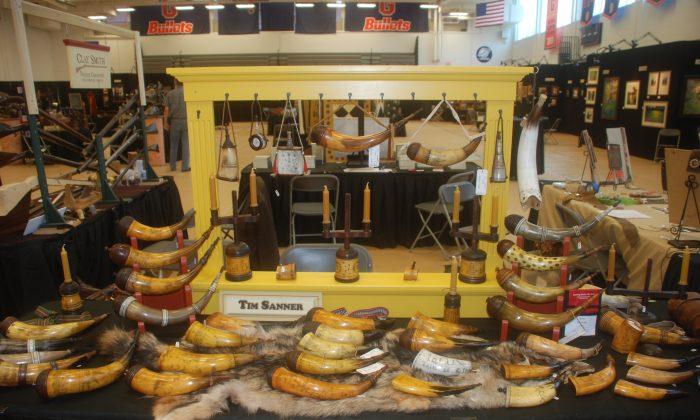Easter Sunday began with rain and a little mist. The day cleared by eleven a.m. Captain Jason Landau eased Little Deeper away from its dock at the Blue Heron Bridge Marina. Captain Landau decided on reef dives south of the Palm Beach Inlet.
The Alaska, a gigantic dredge, was operating in the inlet that separated Palm Beach, Fla., from Singer Island. Tug boats, like the Miss Emily, were alongside in the channel. The dredge was operating in the inlet.
Dredging is never a good sign for Florida reefs. Communities insist on having sand restored to their beaches every season only to watch seasonal winter storms take it away.
“It’s a natural process. What nature removes it eventually puts back. Dredging is a destructive and costly waste of taxpayer money,” the late Dr. Robert Snyder said.
Dr. Snyder was a pioneer oceanographer and participant in many beach arming programs that depended on natural flora and environmentally safe ways of preventing beach erosion. Development and building on ocean shores removed many of nature’s armaments that prevented erosion.
Dredging to restore ocean beaches is a process of taking sand from deeper places offshore and pumping it onto the beach. Dredging, by its very nature, using large-diameter pipes that snake a mile and more and vacuum sand off the ocean floor, creates spoil that coats coral as it settles. The sand chokes living coral polyps and kills them. Turbidity created by dredging decreases light that kills the marine plant that lives inside coral aiding digestion and coral growth.
Disruption of sandy beaches, the creation of berms and sometimes trenches, makes it impossible for turtles to nest successfully. The use of ocean sand which is of a darker color than usual beach sand, increases temperature. Raising temperatures only about 4.5 degrees causes turtles to become females. Males hatch out at a cooler temperature. Anyone that has walked barefoot on black asphalt knows how hot it is compared to white concrete.

These issues aside Easter Sunday turned into a magnificent day with seas of only about three feet. Captain Landau dropped his divers on Ron’s Reef south of the Breaker’s Hotel. There was a northerly flowing current, which meant that once underwater divers would drift north into a place called Flower Garden. There was unlimited visibility. The ocean temperature was a comfortable 76 degrees Fahrenheit (24.4ºC). A perfect day underwater.
The Breaker’s Hotel is a landmark for fishermen and divers. Reefs about a mile offshore, north and south of the famous hotel, are among the most beautiful in the world. Florida’s Palm Beach County offshore reefs are considered not only the best reefs in the United States for diversity of life and important coral formations, divers from all over the world venture to Palm Beach to explore and photograph the reefs that form a chain from south of Boca Raton north to Jupiter.
While the reef structure changes, generally eons of coral growth has formed ledges on the inshore side in about 60 feet depth to the sand. The outside edge of the reefs are in about 80 feet depth to the sand. Reefs vary from narrow to very wide at places spanning a quarter-mile across the top.
The reefs off Palm Beach County, as those off Broward and Miami-Dade Counties, support all manner of marine life. The reefs act as a natural barrier against the fury of storms and hurricanes. The northward flowing Gulf Stream meanders inshore and not only carries away canal and inlet effluent, the Stream brings with it ocean creatures that make diving here exciting.
Damage
Once divers were in the water, they discovered something that suddenly made our Easter Sunday much less joyful.
“There is a swath four feet wide. Basket sponges are cut in half, knocked over. Coral has been severed,” a diver reported when she and her group surfaced. “I took video tape of it. It’s as if a gigantic anchor has been dragged over the entire reef. There is massive damage.”
Captain Landau took out his clipboard and noted the report asking divers questions about what they saw. The divers told him they were on the inside of the reef in 60 feet depth when they observed the damage.
“This has to be reported to the DEP,” he said. He got particulars of the damage and where it was seen. Florida’s Department of Environmental Protection (DEP) would be the agency responsible for conducting an investigation of the damage. The group of divers that witnessed the underwater carnage were concerned and upset. A large tug boat associated with the dredging operation in the inlet was stationed offshore of Little Deeper.

On the second dive Captain Landau dropped divers on a spot called South Breakers, north of where we had been diving. There was only a three-quarter knot northward current. Visibility was still unlimited.
I swam from the western side of the reef across to the eastern edge that was in 60- to 70 feet of water and went north with the current. As I came up along the reef’s edge I observed a wide swath of destruction.
This was at another site but it was as the first group of divers reported. Basket sponges had been sheared off, cut in half, tumbled over, broken. A wide area of coral damage appeared as if a twister touched down and bore along the reef.
Coral was ripped away, gorgonians torn out, marine life destroyed. I photographed the underwater mayhem and followed its trail.
A man-made twister came through the middle of the reef. What was in its path was dead, destroyed. I followed the trail until it led over the reef, down the other side then into the sand. There were no fluke marks that would indicate an ocean going ship dragged its anchor. The trail in the sand was a wide, round groove. I followed it and saw it snake up onto another reef.
This was no accidental ship’s grounding, no Sunday boater ignorant of regulations that prohibit anchoring on coral reefs. This damage was caused by a deliberate use of major machinery. The swath and extent of the damage to the reefs was tantamount to the worst man-made environmental disaster to Palm Beach reefs in history.
Captain Landau took the information from me, inquired about my photographs and noted it on his dive manifest. A woman that videotaped the damage on the first dive was adamant. I suggested she report it to proper authorities and make her videotape available.
The Easter Sunday dives were among the most beautiful underwater cathedrals in the world. The adamant destruction was deliberate. The configuration and shape of the dragging in the sand indicated it was caused by a large round object akin to a long dredge pipe.
When I reported the reef damage to Ed Tichnor, a director of Palm Beach County Reef Rescue, he stated that he was waiting for just such a report. “I’ve been tracking the dredge operation on ‘Ship Tracker,’” Tichnor stated.
Tichnor followed movements of the dredge operation in and around the Breaker’s Hotel offshore areas. He anticipated calls from divers. Mine was the first call. He stated that he would report the matter to Florida’s DEP. Tichnor further reported that the dredge R.S. Weeks was present in the area.
“They have a Reef Injury Response Team. The faster they get out there the faster they can assess and try to repair the damage,” Tichnor stated.
Palm Beach County’s offshore reefs are part of Florida’s underwater heritage. They offer divers and fishermen the opportunity to explore vast areas of pristine coral formations. Reefs support life in the oceans and are of major economic benefit to the area. While Florida authorities will have the reports, the damage has been done and it cannot be feasibly repaired. It will require many years to restore undersea growth. It will require years to heal the ugly scar created by conduct with wanton disregard for the law.
John Christopher Fine has authored 25 books, including award-winning books dealing with ocean pollution. He also writes for major magazines and newspapers in the United States and Europe. He is a master scuba instructor and instructor trainer and expert in maritime affairs.





